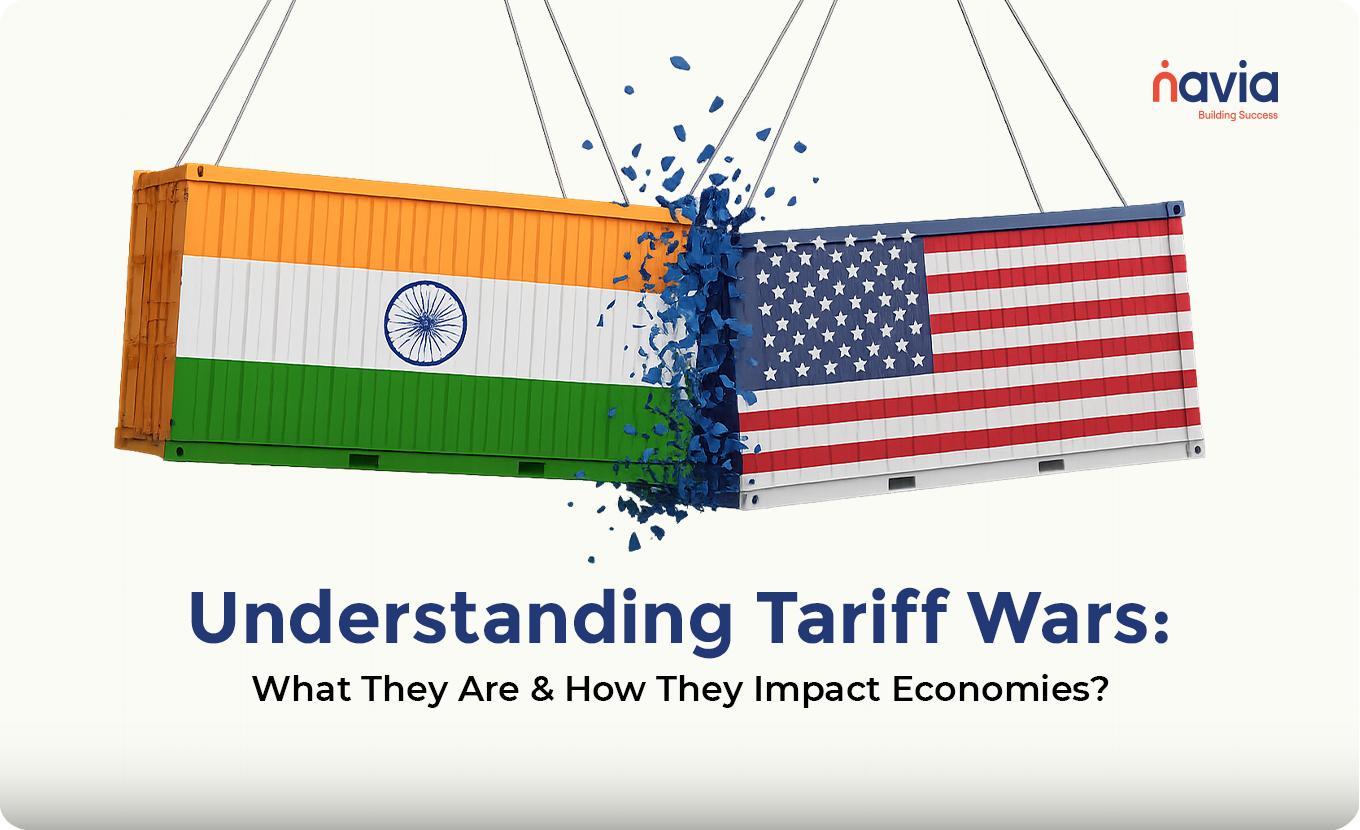Tariff Wars in 2025: Meaning, Real Examples & How They Affect India

Introduction: What is a Tariff War?
A tariff war refers to a situation in which countries impose import tariffs or trade barriers on each other’s goods in retaliation for similar actions taken by the other side. Tariffs are taxes imposed on imports or exports between countries, and when nations engage in a tariff war, they escalate these taxes as a way to protect domestic industries or punish other countries for unfair trade practices.
In a tariff war, the cycle of retaliation continues as each country imposes higher tariffs in response to the tariffs imposed by another. This results in disrupted trade flows, potentially rising consumer prices, and strained international relationships. Although tariff wars can be short-term bargaining tactics, they often lead to long-lasting economic consequences, including trade imbalances, loss of market access, and increased costs for businesses and consumers.
How Do Tariff Wars Start?
Tariff wars typically begin when one country imposes tariffs to protect its domestic industries or reduce a trade deficit. The targeted country usually retaliates by imposing its own tariffs. A tariff war escalates when both countries continue to increase tariffs on each other’s goods. While the immediate goal might be to leverage trade negotiations or address unfair trading practices, the longer-term impact can be detrimental to the global economy.
The History of Tariff Wars
Tariff wars are not a new phenomenon. They have been part of economic history for centuries, often influencing global trade policies and international relations. Here are some notable historical tariff wars:
1. The Smoot-Hawley Tariff Act (1930)
The Smoot-Hawley Tariff Act is one of the most infamous examples of a tariff war. Enacted by the United States during the Great Depression, the act raised U.S. tariffs on over 20,000 imported goods to protect American jobs and industries. However, other nations retaliated by imposing their own tariffs, leading to a steep decline in global trade and exacerbating the effects of the Great Depression. The resulting global trade collapse is often cited as one of the factors that deepened the economic crisis of the 1930s.
🠖 Outcome: The Smoot-Hawley Act is widely considered to have worsened the Great Depression and led to a sharp decline in international trade, with global GDP dropping by around 25%. Countries retaliated with their own tariffs, and the trade war strained diplomatic relations.
2. The U.S.-China Tariff War (2018-Present)
A more recent example of a tariff war is the U.S.-China trade war. In 2018, the U.S. under President Donald Trump imposed tariffs on $34 billion worth of Chinese goods, accusing China of unfair trade practices, intellectual property theft, and currency manipulation. In response, China retaliated with tariffs on U.S. goods. This tariff war escalated, with both sides increasing tariffs on a wide range of products, from technology and machinery to agricultural products.
🠖 Outcome: While the trade war led to a reduction in bilateral trade between the U.S. and China, the broader global economic effects were mixed. On one hand, both countries suffered from higher costs on goods, reduced trade, and economic uncertainty. On the other hand, China’s shift toward self-reliance in certain sectors and the U.S.’s efforts to bring some manufacturing back to its shores were seen as long-term outcomes. The U.S. also imposed tariffs to encourage companies to relocate their production from China, but this has had limited success.
3. The European Union and the U.S. (2002)
In 2002, the U.S. imposed tariffs on steel imports under President George W. Bush, citing the need to protect domestic steel producers. The European Union and other countries retaliated with tariffs on U.S. goods, such as motorcycles, bourbon, and steel products.
🠖 Outcome: The World Trade Organization (WTO) intervened and ruled that the U.S. tariffs violated global trade rules. This tariff war lasted a few years, but in the end, the U.S. was forced to remove tariffs after the ruling. The EU and other countries suffered from reduced access to the U.S. market, while American steel producers did not gain as much as anticipated.
Impact of Tariff Wars on Economies
Tariff wars typically have several key impacts on economies:
🔸 Disruption of Trade: Tariffs disrupt established trade relationships, leading to reduced imports and exports. Companies that rely on cross-border trade may suffer, especially in industries like electronics, automotive, and agriculture.
🔸 Increased Prices for Consumers: Tariffs increase the cost of goods. This is because higher import tariffs make foreign goods more expensive, leading companies to pass on the cost to consumers. This often results in inflation and a reduction in consumers’ purchasing power.
🔸 Economic Uncertainty: Tariff wars create uncertainty in global markets, affecting investment decisions. Businesses may delay or cancel projects due to the unpredictability of future trade policies and prices.
🔸 Retaliation and Escalation: Tariff wars often escalate as each side retaliates with higher tariffs, leading to an ongoing cycle of punitive actions. This harms global trade flows and undermines international cooperation.
🔸 Impact on Supply Chains: Companies that rely on global supply chains face higher production costs and delays in sourcing materials or components. This is particularly impactful in industries such as electronics, manufacturing, and automotive.
How Will India Be Impacted by Tariff Wars?
India, with its growing economy and large manufacturing base, is likely to experience both positive and negative effects from tariff wars, especially in the context of the U.S.-China trade war and rising global protectionism.
Negative Impacts on India:
🠖 Increased Import Costs: India imports many goods, including oil, metals, and electronic components, from countries involved in tariff wars. Higher tariffs on these imports will increase costs for Indian businesses, leading to higher production costs and inflationary pressures.
🠖 Global Trade Slowdown: As global trade slows due to the imposition of tariffs, India’s export-oriented industries, particularly those in textiles, automobiles, and pharmaceuticals, will be impacted by lower demand and reduced access to markets.
🠖 Disruptions to Supply Chains: Companies in India that rely on raw materials from countries embroiled in tariff wars will face supply chain disruptions and higher costs for key components, potentially leading to delays and reduced productivity.
Positive Impacts on India:
🠖 Shifting Manufacturing Base: Tariff wars, especially between the U.S. and China, have led many companies to rethink their supply chains and manufacturing bases. India stands to benefit as multinational companies may relocate their production from China to India, attracted by lower labor costs and improving infrastructure.
🠖 Exports of Indian Goods: Some sectors may benefit from tariff wars as countries seek alternatives to Chinese goods. For instance, Indian pharmaceutical companies may see increased demand as countries look for alternatives to Chinese APIs (Active Pharmaceutical Ingredients).
🠖 Stronger Domestic Manufacturing: Tariff wars often encourage countries to focus on domestic production. In India, the “Make in India” initiative could benefit as tariffs increase on imported goods, making Indian-made products more competitive.

Sectors Likely to Suffer from Tariff Wars in India
1. Electronics and Consumer Goods:
India imports many electronic goods and components, especially from China and the U.S. Increased tariffs will raise the prices of products such as smartphones, televisions, and home appliances, which will affect consumers’ purchasing power.
2. Automobile Industry:
The Indian automotive industry depends on global supply chains for raw materials and components. Higher tariffs on imported parts may lead to higher production costs and delays in the manufacturing process.
3. Agricultural Sector:
India imports agricultural inputs such as machinery and fertilizers from countries involved in tariff wars. Higher tariffs on these products could lead to increased costs for farmers and agricultural producers.
Sectors Likely to Do Well
1. Pharmaceuticals:
India is one of the largest producers of generic drugs. As countries seek alternatives to Chinese pharmaceutical products, India’s pharmaceutical exports may rise, benefiting from tariff wars.
2. Textiles:
India is a major exporter of textiles, and tariff wars might prompt countries to look to India as an alternative to China for their textile needs. This sector could experience growth in exports.
Conclusion: Navigating the Impact of Tariff Wars
While tariff wars create disruptions in global trade and affect economies, India stands to gain in some areas, particularly in manufacturing, pharmaceuticals, and IT services. However, the negative effects—rising import costs, supply chain disruptions, and market uncertainty—could hurt certain sectors.
India needs to strengthen its domestic production capabilities, foster strong trade alliances, and capitalize on shifting manufacturing trends to mitigate the adverse impacts of tariff wars. The key to India’s success will lie in adapting to the global shifts caused by tariff wars and using them as an opportunity to emerge as a competitive alternative in the global market.
Do You Find This Interesting?
Frequently Asked Questions
What is a tariff war?
A tariff war occurs when countries impose import or export taxes, known as tariffs, on each other’s goods in retaliation for similar actions. This leads to escalating trade barriers, increased costs for businesses, and disrupted international trade flows. Tariff wars are usually triggered by attempts to protect domestic industries or address perceived unfair trading practices.
How does a tariff war affect India?
Tariff wars impact India’s economy in several ways:
Negative Effects: Increased import costs for Indian businesses, supply chain disruptions, higher consumer prices, and slower export growth, especially for sectors like electronics, automobiles, and agriculture.
Positive Effects: Opportunities arise as global companies shift manufacturing from tariff-hit countries (like China) to India. Sectors such as pharmaceuticals and textiles can benefit from increased demand for Indian alternatives.
What are the pros and cons of tariff wars?
Pros:
- Protect domestic industries from foreign competition
- Encourage local manufacturing and self-reliance
- Can help negotiate better trade terms
Cons:
- Higher prices for consumers and businesses
- Disrupted global supply chains and trade flows
- Increased economic uncertainty and retaliation from other countries
- Potential loss of market access for exporters
How can investors/traders reduce risk during tariff uncertainty?
- Diversify investment portfolios across sectors and geographies
- Track news and government policies on tariffs and trade
- Favor sectors and companies less exposed to global supply chain risks
- Use hedging strategies, like options or futures, to manage market volatility
- Stay nimble: regularly review investments for new risks or opportunities due to shifts in trade dynamics
DISCLAIMER: Investments in the securities market are subject to market risks, read all the related documents carefully before investing. The securities quoted are exemplary and are not recommendatory. Brokerage will not exceed the SEBI prescribed limit.






